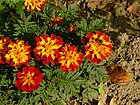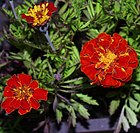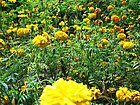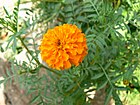Note: This is a project under development. The articles on this wiki are just being initiated and broadly incomplete. You can Help creating new pages.
Difference between revisions of "Tagetes erecta"
(Created page with "{{stub}} ==Uses== {{Uses|}}, {{Uses|}}, {{Uses|}}, {{Uses|}}, {{Uses|}}, {{Uses|}}, {{Uses|}}, {{Uses|}}, {{Uses|}}, {{Uses|}}, {{Uses|}}.<ref name="Uses"/> ==Parts Used== {{...") |
|||
| Line 1: | Line 1: | ||
| − | + | '''African marigold''' is an aromatic, erect, annual plant that can grow up to 180cm tall, but is more likely to be around 25cm. The plant has a wide range of medicinal uses, is also used as a flavouring in food, a popular dye plant and is an effective repellent. It is cultivated as a dye plant in the Americas, and is widely cultivated in temperate to tropical regions as an ornamental plant. | |
==Uses== | ==Uses== | ||
| − | {{Uses|}}, {{Uses|}}, {{Uses|}}, {{Uses|}}, {{Uses|}}, {{Uses|}}, {{Uses|}}, {{Uses|}}, {{Uses|}}, {{Uses|}}, {{Uses|}}.<ref name="Uses"/> | + | {{Uses|Indigestion}}, {{Uses|Colic}}, {{Uses|Severe constipation}}, {{Uses|Coughs}}, {{Uses|Dysentery}}, {{Uses|Sores}}, {{Uses|Ulcers}}, {{Uses|Eczema}}, {{Uses|Sore eyes}}, {{Uses|Rheumatism}}, {{Uses|Boils}}.<ref name="Uses"/> |
==Parts Used== | ==Parts Used== | ||
| − | {{Parts Used|}}, {{Parts Used| | + | {{Parts Used|Leaves}}, {{Parts Used|Flowers}. |
==Chemical Composition== | ==Chemical Composition== | ||
| − | <ref name="chemical composition"/> | + | Twenty five compounds were identified in the oil of T. erecta, of which linalool (22.5 %), 2-hexyl-l-decanol (18.3 %), piperitone (13.4 %), 4-terpinyl acetate (7.8 %) and caryophyllene (6.6 %) are the main components.<ref name="chemical composition"/> |
==Common names== | ==Common names== | ||
| Line 16: | Line 16: | ||
===Dravya=== | ===Dravya=== | ||
===Rasa=== | ===Rasa=== | ||
| − | |||
===Guna=== | ===Guna=== | ||
| Line 29: | Line 28: | ||
==Habit== | ==Habit== | ||
| − | {{Habit|}} | + | {{Habit|Annual}} |
==Identification== | ==Identification== | ||
| Line 48: | Line 47: | ||
==Mode of Propagation== | ==Mode of Propagation== | ||
| − | {{Propagation|}} | + | {{Propagation|Seeds}} |
==How to plant/cultivate== | ==How to plant/cultivate== | ||
| − | <ref name="How to plant/cultivate"/> | + | Requires a well-drained moderately fertile soil in a sunny position. Grows well in heavy clay soils and in sandy soils.<ref name="How to plant/cultivate"/> |
==Commonly seen growing in areas== | ==Commonly seen growing in areas== | ||
| − | {{Commonly seen|}}, {{Commonly seen|}}, {{Commonly seen| | + | {{Commonly seen|Pine-oak forest zone}}, {{Commonly seen|Dry thickets}}, {{Commonly seen|On waste ground}}. |
==Photo Gallery== | ==Photo Gallery== | ||
<gallery class="left" caption="" widths="140px" heights="140px"> | <gallery class="left" caption="" widths="140px" heights="140px"> | ||
| − | + | Gardenplant.JPG | |
| + | Garten-ML (15).JPG | ||
| + | Gefuellte Studentenblume.jpg | ||
| + | Genduphula marigold Odisha.jpg | ||
| + | Gfp-assorted-flowers.jpg | ||
| + | Gondephool (Konkani- गाँडेंफूल) (420116693).jpg | ||
</gallery> | </gallery> | ||
| Line 64: | Line 68: | ||
<references> | <references> | ||
| − | <ref name="chemical composition">[ | + | <ref name="chemical composition">[https://www.tandfonline.com/doi/abs/10.1080/0972060X.2009.10643747#:~:text=Twenty%20five%20compounds%20were%20identified,%25)%20are%20the%20main%20components. Chemical constituents]</ref> |
| − | <ref name="Leaf">[ | + | <ref name="Leaf">[Morphology]</ref> |
| − | <ref name="How to plant/cultivate">[ | + | <ref name="How to plant/cultivate">[http://tropical.theferns.info/viewtropical.php?id=Tagetes+erecta Cultivation]</ref> |
<ref name="Uses">Indian Medicinal Plants by C.P.Khare</ref> | <ref name="Uses">Indian Medicinal Plants by C.P.Khare</ref> | ||
</references> | </references> | ||
==External Links== | ==External Links== | ||
| − | * [ ] | + | * [https://plants.ces.ncsu.edu/plants/tagetes-erecta/ Tagetes erecta on plants.ces.ncsu.edu] |
| − | * [ ] | + | * [https://pfaf.org/user/Plant.aspx?LatinName=Tagetes+erecta Tagetes erecta on pfaf.org] |
| − | + | ||
[[Category:Herbs]] | [[Category:Herbs]] | ||
Revision as of 17:37, 23 July 2020
African marigold is an aromatic, erect, annual plant that can grow up to 180cm tall, but is more likely to be around 25cm. The plant has a wide range of medicinal uses, is also used as a flavouring in food, a popular dye plant and is an effective repellent. It is cultivated as a dye plant in the Americas, and is widely cultivated in temperate to tropical regions as an ornamental plant.
Contents
- 1 Uses
- 2 Parts Used
- 3 Chemical Composition
- 4 Common names
- 5 Properties
- 6 Habit
- 7 Identification
- 8 List of Ayurvedic medicine in which the herb is used
- 9 Where to get the saplings
- 10 Mode of Propagation
- 11 How to plant/cultivate
- 12 Commonly seen growing in areas
- 13 Photo Gallery
- 14 References
- 15 External Links
Uses
Indigestion, Colic, Severe constipation, Coughs, Dysentery, Sores, Ulcers, Eczema, Sore eyes, Rheumatism, Boils.[1]
Parts Used
Leaves, {{Parts Used|Flowers}.
Chemical Composition
Twenty five compounds were identified in the oil of T. erecta, of which linalool (22.5 %), 2-hexyl-l-decanol (18.3 %), piperitone (13.4 %), 4-terpinyl acetate (7.8 %) and caryophyllene (6.6 %) are the main components.[2]
Common names
| Language | Common name |
|---|---|
| Kannada | |
| Hindi | |
| Malayalam | |
| Tamil | |
| Telugu | |
| Marathi | |
| Gujarathi | |
| Punjabi | |
| Kashmiri | |
| Sanskrit | |
| English |
Properties
Reference: Dravya - Substance, Rasa - Taste, Guna - Qualities, Veerya - Potency, Vipaka - Post-digesion effect, Karma - Pharmacological activity, Prabhava - Therepeutics.
Dravya
Rasa
Guna
Veerya
Vipaka
Karma
Prabhava
Habit
Identification
Leaf
| Kind | Shape | Feature |
|---|---|---|
Flower
| Type | Size | Color and composition | Stamen | More information |
|---|---|---|---|---|
| {{{5}}} |
Fruit
| Type | Size | Mass | Appearance | Seeds | More information |
|---|---|---|---|---|---|
Other features
List of Ayurvedic medicine in which the herb is used
Where to get the saplings
Mode of Propagation
How to plant/cultivate
Requires a well-drained moderately fertile soil in a sunny position. Grows well in heavy clay soils and in sandy soils.[4]
Commonly seen growing in areas
Pine-oak forest zone, Dry thickets, On waste ground.
Photo Gallery
References
- ↑ Indian Medicinal Plants by C.P.Khare
- ↑ Chemical constituents
- ↑ [Morphology]
- ↑ Cultivation
External Links
- Ayurvedic Herbs known to be helpful to treat Indigestion
- Ayurvedic Herbs known to be helpful to treat Colic
- Ayurvedic Herbs known to be helpful to treat Severe constipation
- Ayurvedic Herbs known to be helpful to treat Coughs
- Ayurvedic Herbs known to be helpful to treat Dysentery
- Ayurvedic Herbs known to be helpful to treat Sores
- Ayurvedic Herbs known to be helpful to treat Ulcers
- Ayurvedic Herbs known to be helpful to treat Eczema
- Ayurvedic Herbs known to be helpful to treat Sore eyes
- Ayurvedic Herbs known to be helpful to treat Rheumatism
- Ayurvedic Herbs known to be helpful to treat Boils
- Herbs with Leaves used in medicine
- Habit - Annual
- Index of Plants which can be propagated by Seeds
- Herbs that are commonly seen in the region of Pine-oak forest zone
- Herbs that are commonly seen in the region of Dry thickets
- Herbs that are commonly seen in the region of On waste ground
- Herbs





